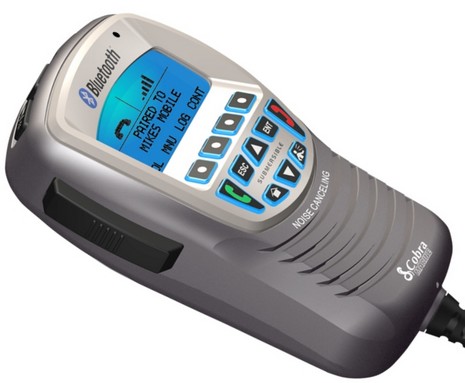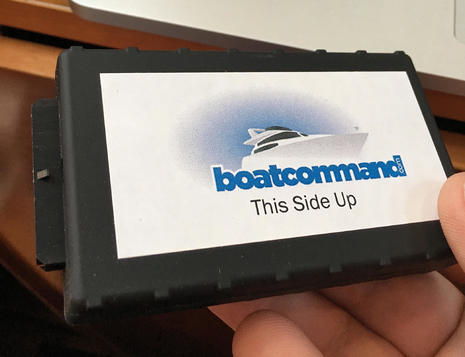Cobra MR F300, a marine Bluetooth cell mic!

What a good idea! Today Cobra is introducing its MR F300 BT Bluetooth handset, which seems carefully designed to make a cell phone work better, and live longer, on a boat. It’s a waterproof marine-style mic with noise-canceling technology on both the receive and transmit sides. It even has a Push-To-Talk (PTT) button like a VHF mic, but in this case it’s really a reverse mute button. In other words, you and your caller will hear no amplified boat noise unless you push the button (and you’ll still hear your caller even when the button is pushed). But if it’s quiet on the boat, there’s a dedicated button for hands-free speaker phone mode. In fact, the 4.5” tall mic even has soft keys able to call up a 50 number received call log and equal size phone book, and other features like 10 ring tones that can be individually assigned to regular callers {correction due to Cobra Web error, now also corrected: there’s just a choice of 10 tones, not selectable by caller}.
The diagram below shows how the F300 is wired via a waterproof helm outlet to your boat’s power supply and even to its stereo set, if you want. And it comes with a USB plug for easy firmware updates if needed (Bluetooth seems to be a pretty stable and pervasive wireless standard these days, but no doubt there will be updates to phones that might necessitate updates to the mic). I spoke with Cobra marine product manager Bill Boudreau about the F300 and was impressed with how much research the company did during its development. Plus I learned that Cobra is leveraging technology mastered while combining Bluetooth cellular with CB radio. And, yes, a similarly combined Bluetooth mic and VHF would be neat, but there’s the problem that VHF, unlike CB, is an official safety tool.
At any rate—as a guy who’s destroyed one cell phone with just a splash (I swear) of saltwater, and know of many similar fatalities—I surely welcome a way to put a phone safely away on a boat, not to mention improved performance at the helm. The F300, by the way, will purportedly ship in September, with an MSRP of $190. The other part of that puzzle is marine cell amplifiers and antennas, and I’ve been meaning to report on the latest from M-Tec, which has really upped its game since first mentioned here. Finally, I’m delighted that Karen and Jeff Siegel have just begun an in-depth series all about cell phones on boats at Mad Mariner. Part One is here.














Wish this wasn’t wired…..might be worth it if I could use it at either helm station and take it boat to boat.
This is pretty neat. There is also a great gadget that uses bluetooth and cell phones now called a Dock-N-Talk. However, it only works with boats that are equiped with phone jacks.
I installed this little box on my boat and it works great. The Dock-N-Talk plugs into a regular phone jack and receives the bluetooth signal from any cell phone. Thew cell signal is converted and sent through the phone lines to any regular telephone that is plugged into a jack. ANy regular phone phone can receive or send calls through this system. The unit can be hidden anywhere on the boat. When I board, I plug my cell into a power plug (cigerette plug) to charge the phone while aboard. The power plug is secured away from the water and open. The bluetooth signal then works like a charm through the regular phones on board.
The mic version here looks great and useful for boats without telephone jacks or who want a single unit.
I have been looking at products like this:
http://tinyurl.com/5rae3h
which come up on e-bay frequently. In operation you would take the sim card out of your phone (if you are gsm service) and put it in the gateway. The gateway antenna connector can then be attached to an amplifier and masthead antennae. The gateway then has a pstn (analog telephone) line that you can then connect to a wireless phone. We Already have a waterproof floating cordless phone onboard for the SAT phone (see http://tinyurl.com/6ynq7d) for a pic of the uniden cordless. We also already have a gsm frequency amplifier and masthead antennae, but no longer have the cell phone that hooks into the docking station we have onboard (similar to dock-n-talk, but VERY limited phone selection unfortunately).
What I really like about this particular model (and some of the others like it) is that it also has a pstn input line which we could connect to the sat phone output. This way both the cellular and SAT phone would ring the same waterproof handset, and a special key combination would allow outgoing phone calls to be placed via the cell or sat depending on reception. The advantage it has over the dock-n-talk is that it is easy to connect to the amplifier and masthead antennae. The downside is that you have to remember to move your sim card back and forth (bigger problem for weekend warrior than long term cruiser).
I haven’t found a retail supplier of such gateways, so support will be limited, but they seem to be in steady supply on e-bay. My understanding is that these sort of things are far more popular in Europe where mobile to mobile calls are FAR cheaper than landline to mobile.
The Simrad WR-20 wireless remote can be used with a Bluetooth cellphone as well as a Simrad VHF and instruments.
It was covered by Ben way back in 2006: https://panbo.com/archives/2006/03/simrad_remote_a_nmea_2000_surprise.html
Ben, did you actually get ’round to testing one? It looks very nice when looking thru the manual, but I haven’t actually tested one. I’m considering going Simrad on the next boat (IS-20 instruments + Simrad VHF + Simrad autopilot) so this would be a great addition.
Kees, I haven’t tested the WR-20 but did see it demoed during a Simrad SART trial in Biscayne Bay. It seemed a bit complicated, but that’s a very limited appraisal, and probably doesn’t apply to folks like you
The gateway suggestion is good, but does seem cumberson to swap out a chip each time you board the boat.
I forgot to mention that with the Dock-N-Talk on my boat, I also have a Digital Antenna wireless amplifer which adds distance to cell calls. While not as effective as a wired version, As I walk on the boat at the dock, the bluetooth signals connect the cellphone and Dock-N-Talk automatically then I can use a regular telephone, through the Dock-N-Talk through my cell phone even on much of the backside of Santa Cruz Island!
It does work relatively well!
Good stuff, can’t see buying this myself, but I enjoy reading about all these innovations. Way to go Ben !
Could really see making this bluetooth based.
Another idea for Cobra … how about coupling this baby with a cell phone jammer capability ? A very low db signal that causes the connected cell phone, and all the cellphones on the boat that they should connected to an imaginary tower. Throw a switch and the product goes from enhancing cell phone usage, to silencing them for a preset period … like an hour or two. It drives me nuts when people take phone calls in the middle of a racing manuvere. “hi honey, yes in fact we are racing right now, I am working the … wham … ouch that hurt”
Also helpful to the cruising sailor or boater. Advertise this as a silence / sleep feature. Girls are sunning on the deck, guys have beers in their hands, and the silence of the cell phones keeps the mood going.